If you are looking to install a new AC or replace an older model, the number of options to choose from is daunting.
This guide explains the differences between dual and variable speed ACs and where and why to use each type, and which is the most suitable.
2 Stage vs Variable Speed Air Conditioner

Two-Stage Air Conditioner
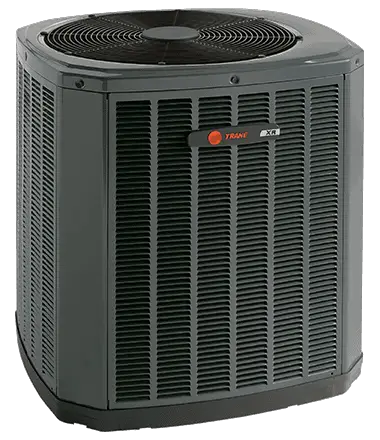
Variable Speed Air Conditioner

Pros
Two-Stage Air Conditioner
Longer AC lifespan
It runs at two speeds
Savings on energy bills compared to single-stage units
Variable Speed Air Conditioner
Longer lifespan
Varies speed at need
Most energy efficient
Cons
Two-Stage Air Conditioner
High initial cost
Difficult to repair
SEER rating may be misleading for poorly insulated homes
Variable Speed Air Conditioner
Difficult to repair
Highest initial cost
A complex VFD controller system
Best For
Two-Stage Air Conditioner
A home in a hot climate, on a moderate budget
Variable Speed Air Conditioner
A home in a sweltering and humid climate, where indoor air quality is essential
What is a Two-Stage Air Conditioner, and How Does a Two-Stage AC Work?
A two-stage air conditioner (AC) has a compressor capable of running at two different speeds. The compressor is the component that moves refrigerant around the system. The thermostat signals the compressor to start when the temperature rises above the desired setting on single-stage systems. Once the home is cooled sufficiently, the thermostat signals the compressor to stop.
With a dual-stage system, the compressor still starts at 100% capacity when the temperature is high. Yet, as the heat begins dropping into the comfort range, the thermostat signals it to change to the lower speed setting of around 70% of the full capacity.
Like the single-stage system, the compressor stops once the temperature drops to the bottom of the range.
The compressor consumes more power when starting than it does while running, even at 100% capacity. By adding the extra stage of lower cooling, the compressor runs longer, cooling your home more thoroughly and reducing the number of costly starts and stops.
The longer running cycle also dehumidifies the dwelling more effectively and reduces wear and tear on the overall system.
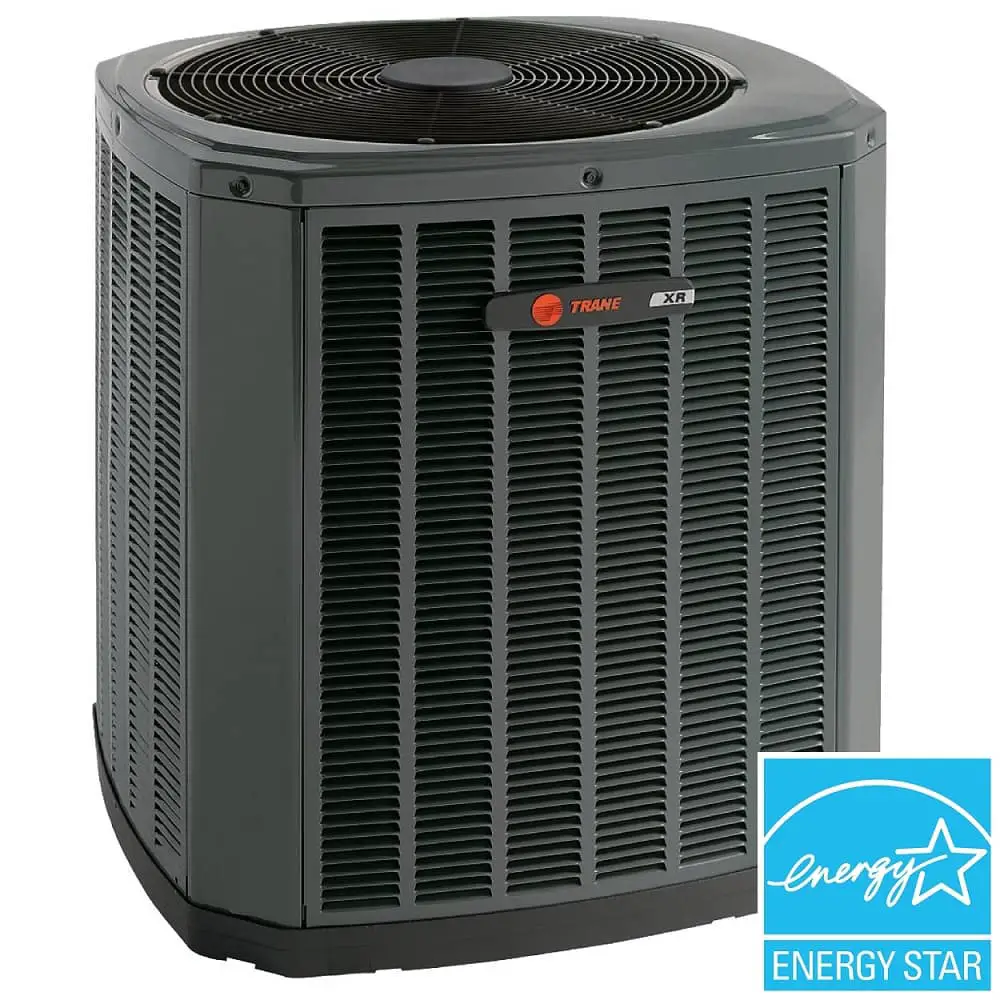
What is a Variable Speed Air Conditioner, and How Does a Variable Speed AC Motor Work?
Variable speed ACs have a variable frequency drive (VFD) to control the compressor’s speed. VFDs can also control fan speeds on the air handler unit instead of using a mechanical form of throttling the flow. The VFD controls the motors’ speed by adjusting the input voltage and frequency through a control circuit and inverter.
The thermostat signals the VFD, telling it when to increase or decrease the motor speed. The more refined control over the compressor’s speed means that the compressor is continuously running in the optimal load condition for the required amount of cooling.
What this means for the AC is that it runs for more extended periods at lower loads than either a single or dual stage AC. Fewer stops and starts mean more even cooling in your home, better humidity control, less wear and tear, and most importantly, lower energy consumption.
Additionally, the reduced speed results in a quieter operation, especially if the air handler unit fan also has a VFD. The AC runs at 100% capacity if needed but can reduce speed to around 30% once your cooling needs are lower.
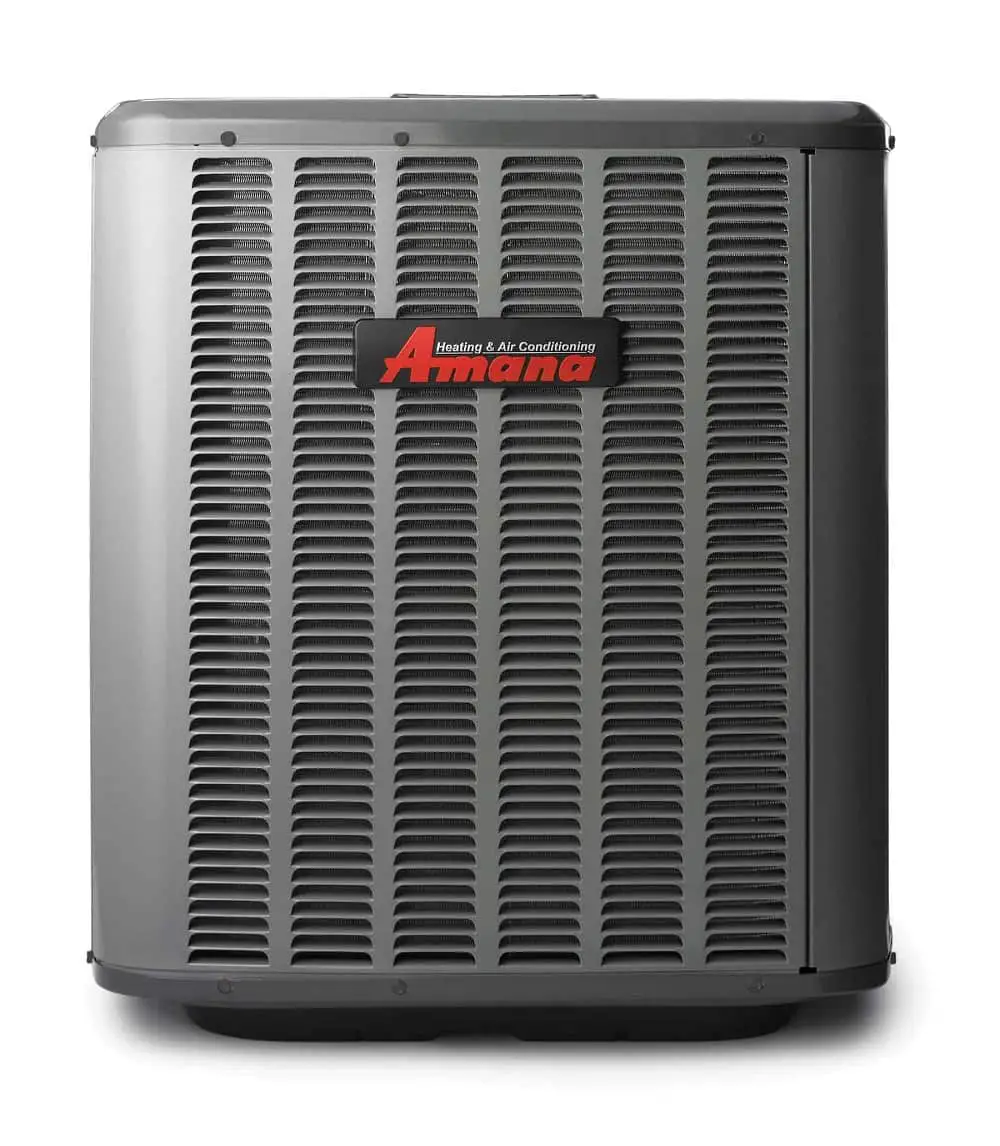
Relevant Characteristics Between 2 Stage and Variable Speed Air Conditioner
2 Stage vs Variable Speed Air Conditioner
Compare by tapping or clicking below!

Energy Efficiency
2 Stage Air Conditioner
16-19 SEER
Variable Speed Air Conditioner
18-26 SEER
Temperature Control
2 Stage Air Conditioner
+/-3°F
Variable Speed Air Conditioner
+/-2°F
Noise
2 Stage Air Conditioner
66-75dB
Variable Speed Air Conditioner
51-75dB
Cost
2 Stage Air Conditioner
$5,200-$9,500
Variable Speed Air Conditioner
$8,000-$14,500
Similarities and Differences
Now that we know what a two-stage and variable speed AC is, we’ll discuss the similarities and differences between the different systems. Discussing the similarities and differences and their implications helps with the decision-making process to give you confidence that you have chosen the right AC for your home.

Two-Stage and Variable Speed Air Conditioner Differences
The most significant difference between the dual speed and variable speed systems is the compressors’ speed control. A dual-speed motor consists of two windings, each capable of running independently of the other.
When the load is high, the high-speed winding is in operation. As the load reduces, this winding cuts out, and the motor runs at a slower speed. The variable-speed motor is controlled electronically by the VFD, making the speed control more refined.
The different methods and degrees of speed control result in the following significant differences between the systems:
Purchase Price
The more complex and advanced speed control of the variable speed AC makes this unit’s initial cost higher than the dual-stage package. The potential long-term energy savings offset the high initial price.
Maintainability
Although you may not want to think about the possibility that your newly installed AC can experience breakdowns, maintainability is an important consideration. Fewer technicians are qualified to work on variable speed motors than dual-speed motors, and they charge more.
Replacement parts for the speed controllers are also more expensive. Variable speed ACs will cost more to maintain and repair than dual or single-speed systems.
Indoor Air Quality
The longer running cycle of a variable speed compressor means that the entire system runs for more extended periods, filtering and dehumidifying the air throughout the process. More constant filtering means fewer allergens and cleaner air in your home, and improved dehumidification results in less stickiness and more comfort.
The longer running cycle also results in more occasional temperature spikes in your home and a smaller temperature range.

Two-Stage and Variable Speed Air Conditioner Similarities
Whichever of the two systems you choose, they are both designed to provide fresh, cold, and comfortable air in your home. The better technology that goes into these systems offers many similar benefits, such as improved energy efficiency and temperature control, reduced noise levels, and higher reliability.
Energy Efficiency
Both the dual-speed and variable speed options are energy-efficient modes of air conditioning. The variable speed drive’s added control gives a higher SEER rating, but both types are considered energy efficient.
Noise Levels
The lengthened cooling cycle and fewer restarts these systems make for excellent noise reduction. Although the variable speed AC’s noise levels are the lowest, even the two-speed models are quiet in operation. The lower noise levels afforded by these machines mean better overall comfort in your home.
Temperature Control
The primary reason for installing an AC is temperature control in your home. Both of these systems provide adequate temperature control, with minimal variations between high and low temperatures. The variable speed AC does provide a tighter control, but both of these systems give comfortable and even cooling throughout your home.
High Reliability
Maintenance intervals on the major components of these systems are longer than for older types of AC. You can’t avoid the need for cleaning filters and coils regularly, but you can minimize the need for maintenance and repairs on compressors, the most expensive part of the system.
The reduced amount of wear and tear on the AC gives both types of AC increased longevity and higher reliability than less advanced ACs.
What About Single Stage Air Conditioners?
Single-stage air conditioners have one advantage over two-speed or variable-speed AC systems, which is the low initial cost. If your budget for a new or replacement AC is low, then a single-stage AC could be a viable alternative.
Bear in mind, though, that the cheaper initial installation also has long-term downsides—the lower SEER rating results in higher energy bills. The increased wear and tear on the overall system lead to lower reliability and more frequent maintenance.
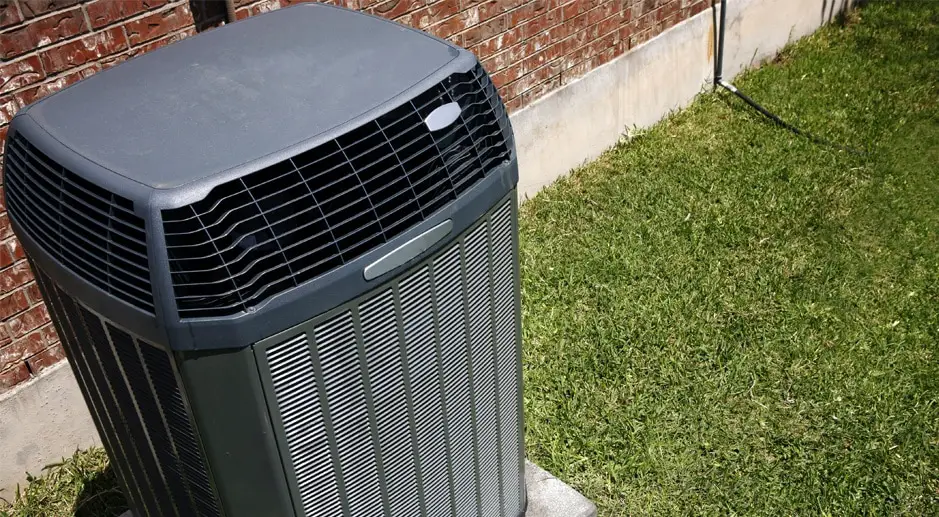
A single-stage AC is either on and blasting cold air through your home at 100% capacity or idle, waiting for the temperature to rise and the thermostat to signal a restart. Although a faster cooling cycle may seem like a good thing, it has several negative implications on the comfort of your home.
While the system is idle, the humidity levels are rising along with the temperature. With the fans off, the air isn’t circulated through the filters, resulting in lower air quality.
The shorter running time of the compressor and fans also means that cold air doesn’t have the same amount of time to penetrate to all parts of the rooms. Furthermore, you end up with hot and cold spots.
The compressor’s shorter running time also means more frequent starts and stops, leading to higher and more intrusive noise levels. Instead of a constant low hum in the background, you have the noise of the compressor starting and stopping and the increased noise of the AC running at 100% load, rather than the 30-70% of two-speed or variable speed systems.
The reduced comfort and reliability and increased running costs of this type of AC mostly outweigh the short-term attraction of the lower initial price of a single-stage AC.
When Would a Two-Stage AC Be the Best Choice?
It seems like more variability is always better, but when is a two-stage actually a better choice?

Budget
Your new AC system will last between ten and thirty years, so the final decision needs careful consideration, and you want to get the best you can afford. If your immediate budget doesn’t stretch far enough for a variable speed system, then the two-speed is a great compromise.
These systems are affordable enough not to break the bank, but still energy efficient enough to save on long-term high energy bills.
Climate
Another consideration is whether or not the amount of time that your AC runs justifies the extra cost of the variable speed AC. If you live in an area where the climate isn’t warm year-round or the humidity is low enough that there is no necessity for the longer running time of the variable speed AC, the two-stage option is the best choice.
Maintenance Availability
The final but no less important factor to look at is whether there are service technicians in your area that can repair and maintain the variable speed motors. A two-stage AC is the best choice when the expertise to support the more advanced and complex variable speed ACs is not available in your area.
Common 2 Stage Air Conditioner Problems
Two-stage ACs don’t come without a few problems, and these should be taken into account as well. We’ve recorded some of the more normal issues below.
Real-World Performance Doesn’t Always Match the SEER Ratings
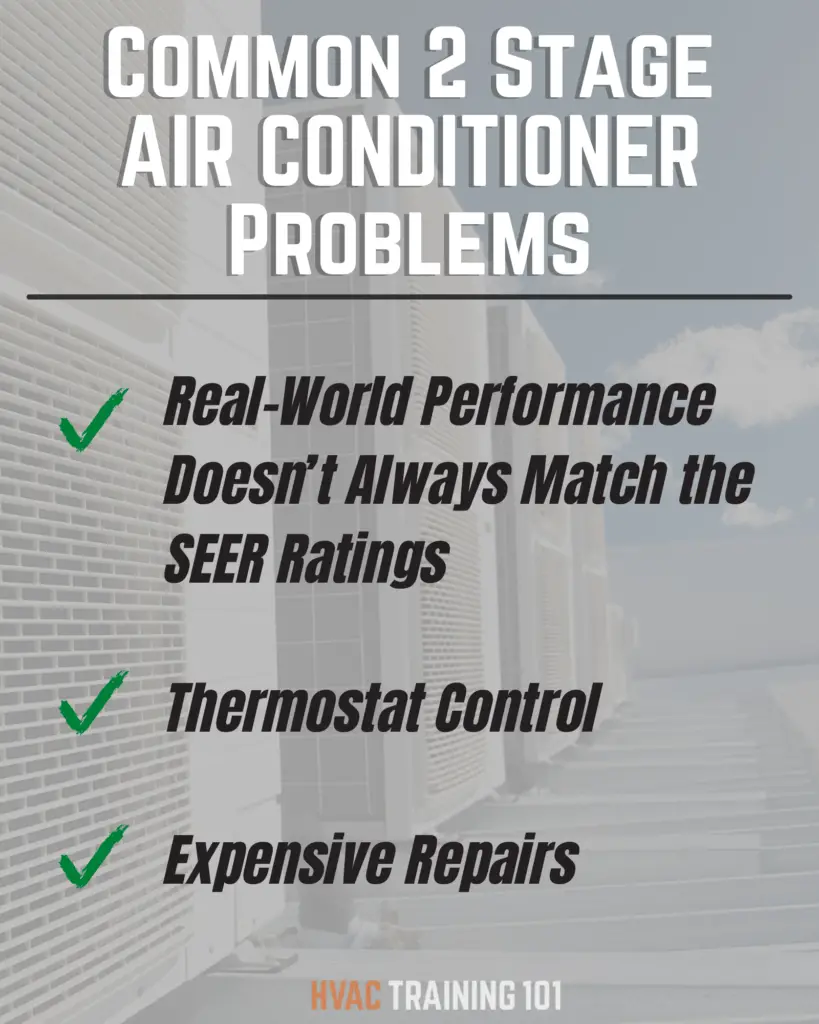
A two-stage AC only reaches its peak performance in well-insulated homes. The SEER may only be 70-80% of the advertised SEER for a poorly insulated home.
The manufacturers aren’t dishonest; the performance is measured under ideal conditions and doesn’t take some environmental factors into account.
Thermostat Control
A two-stage AC needs a two-stage thermostat, and the technician must program the thermostat properly to achieve the proper effect of the two-stage AC.
You may encounter thermostat problems on a retrofitted system or after repairs if the thermostat is incorrectly programmed or the wrong parts fitted.
Expensive Repairs
Compared to a variable speed unit, the repairs and maintenance are cheaper, but they are still expensive. Using a technician who isn’t familiar with two-stage ACs can also cost the homeowner more in the long run, so ensure that you have a service provider nearby with technicians qualified to work on the system you choose.
When Would a Variable Speed AC Be the Best Choice?
Several factors can make the variable speed AC the best choice for a homeowner. We discuss some of these below.
High SEER Rating
The high SEER rating of the variable speed ACs makes them the perfect choice for hot climates where the unit runs all year or for most of the year, allowing the homeowner to take full advantage of utility bills’ savings. High SEER ratings translate into savings on energy bills and lower operating costs for the AC.
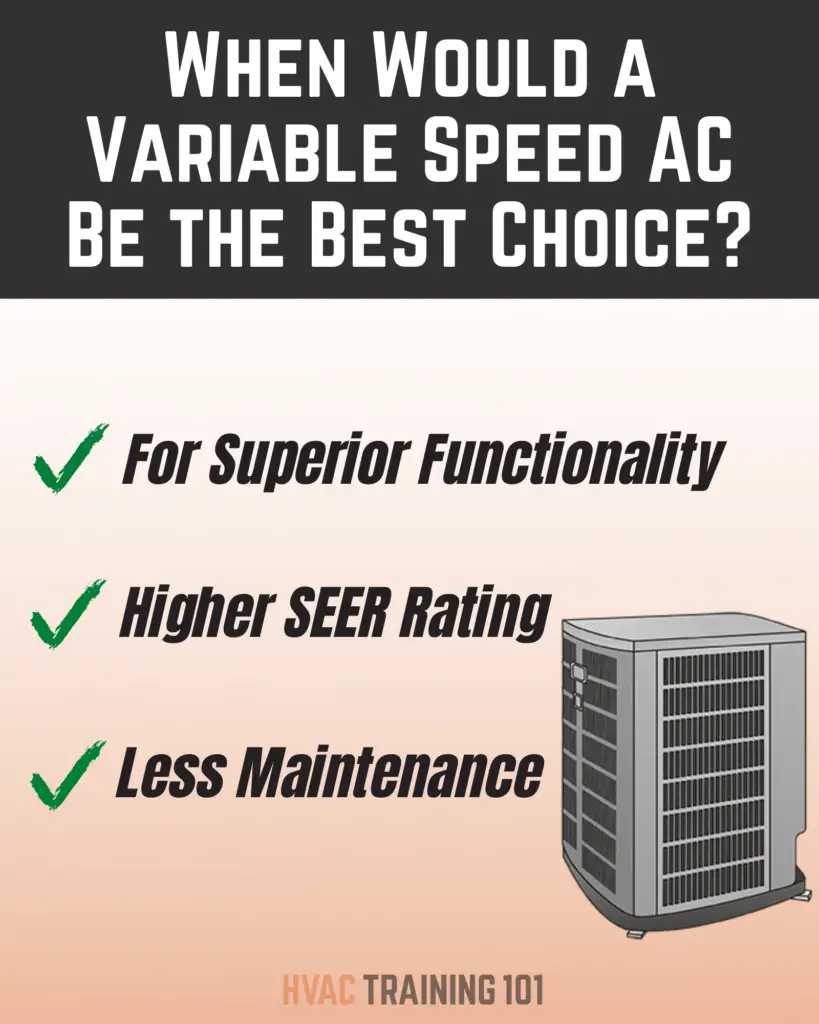
Enhanced Comfort and Air Quality
In an area with high humidity and high particle content in the air, the longer running cycle of the variable speed, AC makes it the best choice. Variable speed units have superior dehumidifying qualities and provide cleaner air to the home, so if these considerations are foremost, then a variable speed AC is what you need.
Reliability
In hot, humid climates, reliability is an essential factor to consider. The reduced wear and tear on the variable speed ACs leads to higher reliability and less downtime. Variable speed units are the best option for homeowners that need their AC to run for long periods without having excessive maintenance done on compressors and fan motors.
Bottom Line
If a lower price is a priority, then a two-stage system is best, but if energy savings and comfort are higher on the list, then a variable speed unit is the answer. Climate and availability of suitably qualified HVAC technicians and spare parts for the different AC types also play a role in making the best choice.
There is no right or wrong answer with any HVAC system, only what is best for the homeowner at the time. The important thing is to weigh the options and decide which design best fits your unique circumstances making the final decision easier.
People Also Ask
There are often additional questions to be answered, so in this section, we try to anticipate and answer questions that people regularly ask regarding two-speed and variable speed ACs.
The easiest way to check is to switch off the power to the unit and open the thermostat. If you have wires connected to terminals marked “Y1” and “Y2” you are dealing with a two-stage cooling system. Heating wires use the “W” terminals inside the thermostat.
Yes, in a hot climate where your AC runs almost all year round, a two-stage AC is worth the extra money, provided your home is well insulated. Two-stage ACs efficiency is not as good for a dwelling with poor insulation and sealing.
In a hot and humid climate, variable speed ACs are definitely worth the extra initial spend. A variable speed AC is the most energy-efficient type for cooling and the most reliable. Variable speed ACs also give the best air quality.
Yes. Variable speed ACs have a higher SEER rating which means that they use less energy over the cooling season, saving you money on your utility bills. The reduced number of starts and stops also means better reliability on the compressor and fewer repair bills.
Electrical and mechanical parts wear out over time, so there are always breakdowns no matter how reliable a system is. However, the variable speed AC is the most reliable compared to single or multi-stage AC systems.
